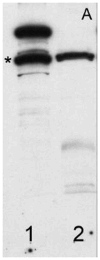Expression of two-pore domain potassium channels in nonhuman primate sperm
- PMID: 17067589
- PMCID: PMC1852539
- DOI: 10.1016/j.fertnstert.2006.06.051
Expression of two-pore domain potassium channels in nonhuman primate sperm
Abstract
Objective: Two-pore domain potassium channels (K(2P)) play integral roles in cell signaling pathways by modifying cell membrane resting potential. Here we describe the expression and function of K(2P) channels in nonhuman primate sperm.
Design: Experimental animal study, randomized blinded concentration-response experiments.
Setting: University-affiliated primate research center.
Animal(s): Male nonhuman primates.
Intervention(s): Western blot and immunofluorescent analysis of epididymal sperm samples. Kinematic measures (curvilinear velocity and lateral head displacement) and acrosome status were studied in epididymal sperm samples exposed to K(2P) agonist (docosahexaenoic acid) and antagonist (gadolinium).
Main outcome measure(s): Semiquantitative protein expression and cellular localization and quantitative changes in specific kinematic parameters and acrosome integrity.
Result(s): Molecular analysis demonstrated expression and specific regional distribution of TRAAK, TREK-1, and TASK-2 in nonhuman primate sperm. Docosahexaenoic acid produced a concentration-dependent increase in curvilinear velocity (P<.0001) with concomitant concentration-dependent reductions in lateral head displacement (P=.005). Gadolinium reduced velocity measures (P<.01) without significantly affecting lateral head displacement.
Conclusion(s): The results demonstrated expression and function of K(2P) potassium channels in nonhuman primate sperm for the first time. The unique, discrete distributions of K(2P) channels in nonhuman primate sperm suggest specific roles for this subfamily of ion channels in primate sperm function.
Figures







Similar articles
-
Expression and localization of two-pore domain K(+) channels in bovine germ cells.Reproduction. 2009 Feb;137(2):237-44. doi: 10.1530/REP-08-0035. Epub 2008 Nov 5. Reproduction. 2009. PMID: 18987255
-
Differential expression of two-pore domain potassium channels in rat cerebellar granule neurons.Biochem Biophys Res Commun. 2014 Oct 31;453(4):754-60. doi: 10.1016/j.bbrc.2014.10.012. Epub 2014 Oct 12. Biochem Biophys Res Commun. 2014. PMID: 25305496
-
Expression of thermosensitive two-pore domain K+ channels in human keratinocytes cell line HaCaT cells.Exp Dermatol. 2007 Dec;16(12):1016-22. doi: 10.1111/j.1600-0625.2007.00626.x. Exp Dermatol. 2007. PMID: 18031461
-
Molecular and functional properties of two-pore-domain potassium channels.Am J Physiol Renal Physiol. 2000 Nov;279(5):F793-801. doi: 10.1152/ajprenal.2000.279.5.F793. Am J Physiol Renal Physiol. 2000. PMID: 11053038 Review.
-
Therapeutic targeting of two-pore-domain potassium (K(2P)) channels in the cardiovascular system.Clin Sci (Lond). 2016 May;130(9):643-50. doi: 10.1042/CS20150533. Clin Sci (Lond). 2016. PMID: 26993052 Review.
Cited by
-
A role for two-pore potassium (K2P) channels in endometrial epithelial function.J Cell Mol Med. 2013 Jan;17(1):134-46. doi: 10.1111/j.1582-4934.2012.01656.x. Epub 2013 Jan 11. J Cell Mol Med. 2013. PMID: 23305490 Free PMC article.
-
The Role of Sperm Membrane Potential and Ion Channels in Regulating Sperm Function.Int J Mol Sci. 2023 Apr 10;24(8):6995. doi: 10.3390/ijms24086995. Int J Mol Sci. 2023. PMID: 37108159 Free PMC article. Review.
-
Extraoral Taste Receptor Discovery: New Light on Ayurvedic Pharmacology.Evid Based Complement Alternat Med. 2017;2017:5435831. doi: 10.1155/2017/5435831. Epub 2017 May 31. Evid Based Complement Alternat Med. 2017. PMID: 28642799 Free PMC article. Review.
-
Regulation and function of the two-pore-domain (K2P) potassium channel Trek-1 in alveolar epithelial cells.Am J Physiol Lung Cell Mol Physiol. 2012 Jan 1;302(1):L93-L102. doi: 10.1152/ajplung.00078.2011. Epub 2011 Sep 23. Am J Physiol Lung Cell Mol Physiol. 2012. PMID: 21949155 Free PMC article.
References
-
- Darszon A, Labarca P, Nishigaki T, Espinosa F. Ion channels in sperm physiology. Physiol Rev. 1999;79:481–510. - PubMed
-
- Visconti P, Westbrook VA, Chertihin O, Demarco I, sleight S, Diekman AB. Novel signaling pathways involved in sperm acquisition of fertilizing capacity. J Repro Immunol. 2002;53:133–150. - PubMed
-
- Beltran C, Zapata O, Darszon A. Membrane potential regulates sea urchin sperm adenylylcyclase. Biochemistry. 1996;35:7591–7598. - PubMed
-
- Goldstein SAN, Bockenhauer D, O’Kelly I, Zilberberg N. Potassium leak channels and the KCNK family of two-P-domain subunits. Nat Rev Neurosci. 2001;2:175–184. - PubMed
Publication types
MeSH terms
Substances
Grants and funding
LinkOut - more resources
Full Text Sources

